The Charles Simpson Endowed Peanut Program Newsletter – Visit now
Summary
Current Research
Breeding for better quality and multiple diseases and/or pest resistance
Utilizing the wild peanut collection as a gene source
The peanut breeding and genetics program in Stephenville has a rich history dating back over 75 years. Today we are focused on using the latest technologies to produce improved peanut cultivars. We concentrate on cultivated peanut variety development, wild species gene introgression, trait enhancement, and germplasm maintenance. The first certified Spanish variety was released from the program in 1950. Since that time the program has continued to meet the needs of today’s modern farmers. To date, the program has released over 20 improved variety and germplasm lines specifically suited for growers in Texas and the Southwest.
Breeding for better quality and multiple diseases and or pest resistance
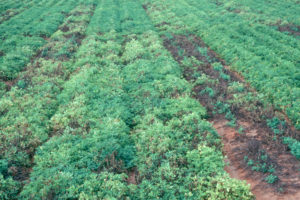
A primary focus of our breeding program is our improved quality and multiple disease resistance (MDR) program. This is a program which involves the pyramiding or stacking of genes for different quality traits and diseases resistances into our current elite breeding lines. It is directly related to our wild species utilization program, from which many of our current resistances come.
Quality is always a concern in peanut production and is a base for any variety we develop. The high O/L trait is one that we incorporate into all of our breeding lines. This trait has been linked to improved health benefits to those who eat it as well as longer shelf life. Which contributes to the shelling, blanching, roasting and taste characteristics all essential traits for shellers, manufacturers, and consumers.
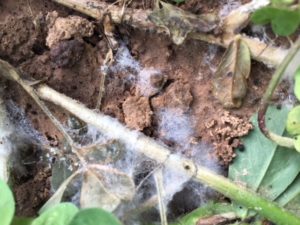
Monetary, as well as, environmental considerations are the primary driving force behind this program. Any reduction in pesticide application is a benefit in both areas of concern. Peanut is subject to many diseases and pests. Use of resistant cultivars has been estimated to have an annual economic impact for the United States peanut producers of $200 million annually. For example, nematode resistance alone has been calculated to have a potential effect of $81 million annually in the United States. Incorporation of other disease resistance traits such as leaf spot and Sclerotinia resistance into our varieties could save a grower from $150/ac worth of spray costs associated with treating for Sclerotinia and upwards of $100/acre in spray costs for leafspot.
We continually increase the number of breeding lines we are working with. We have combined resistance to tomato spotted wilt virus (TSWV), Sclerotinia, leaf spots, and root-knot nematodes. Other traits of interest are evaluated as needed such as Southern Blight, Pod rot, seedling vigor, and early maturity. This program builds on our past successes. We have released varieties with high levels of resistance to Sclerotina minor. We were the first breeding program in the world to identify, develop and release a variety with near immunity to the root-knot nematode (Meloidogyne arenaria).

Additionally, we have varieties and breeding lines with high levels of resistance and/or tolerance to TSWV and leafspot, pod rot, southern blight, and insect resistance. Programs are ongoing in all four market types (Virginia, Runner, Spanish, and Valencia) to combine many of these traits with lines possessing competitive yield and grade. Also, we are now using several of these breeding lines as parents in our drought tolerance crossing program.
Groundwater depletion, climate change and growing competition from population growth have led to an increased interest in drought tolerance in most crops, including peanut. The High Plains of Texas are an excellent example of the increasing concern over drought and groundwater levels. Most of the High Plains of Texas utilize irrigation water coming from the Ogallala aquifer. It has been estimated that median water-levels of the Ogallala aquifer in the Texas Panhandle dropped from 82 to 220 feet in the 70 years since irrigated agriculture has become common.
The project headed by Dr. M.D. Burow at the Lubbock REC, of which we are a part of, has made significant advances to develop drought tolerance for Texas peanut farmers. Two major projects have emerged from this research. We are currently testing lines generated from a drought tolerance screening of the U.S. peanut germplasm mini-core collection. Such traits as:
- Paraheliotropism (leaf angle adjustment)
- Flowering
- SPAD chlorophyll content
- Canopy Temperature
- Height
- Width
- Pod Yield
- Transpiration
- Transpiration Efficiency
- Acquired Thermo-tolerance
- Yield
- Dry matter accumulation
- Root elongation
- Canopy area
All of these traits have been researched to identify characteristics that are associated with drought tolerance. This effort has led to the identification of 28 molecular markers tied to drought tolerance traits. As sequencing technologies have advanced the search for additional SNP markers has progressed for characteristics that have already been identified as well as new ones. Several populations have been developed; in one population where these markers were applied during the selection process, a yield increase of 70% was noted, compared to no selection at all. The enormous potential to assist in the development of new drought-tolerant varieties using marker technology is exciting and represents the future of the overall program. Currently, several populations with drought tolerance traits have been developed that have now moved into statewide replicated trails.
Also, another project showing great promise involves the use of wild species peanuts from the dry northeastern part of Brazil (an area with an average rainfall equivalent to El Paso TX.). This species (Arachis dardani) serves as the donor parent in development of a gene introgression pathway with which to move drought tolerance traits into a cultivated peanut. A transcriptomics study involving imposed drought has revealed an additional 14 candidate genes that are associated with drought.
Utilizing the wild peanut collection as a gene source
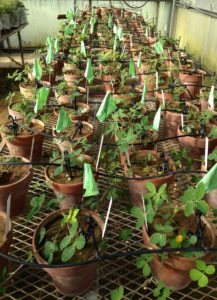
In our pre-breeding program, we utilize the wild peanut collection to introgress genes into cultivated breeding lines that can be used in the peanut breeding programs around the globe to improve the cultivated peanut. This project involves the crossing of numerous species to study the relationship of different accessions, i.e., evolutionary history, of Arachis and thus, to better understand how we may transfer desirable genes from a specific wild species into breeding lines that are cross-compatible with the cultivated peanut. This information lays the groundwork for the development of cultivars. Also, we evaluate (now called phenotyping) wild species for traits of interest. Once an attribute is identified genes must be moved along what has been termed an introgression pathway. This involves developing complex hybrids that are cross-compatible with a species of section Arachis, searching until the hybrid can be crossed with a cultivated peanut line.
In 1976, we participated in the collection of >1800 wild peanut accessions comprising more than 70 new species of the genus Arachis and > 5000 cultivated landraces. We have expanded the gene pool of peanut almost beyond our imagination. Much of this germplasm is maintained at the Stephenville station, and we have made significant progress in utilizing both the cultivated and wild materials. We have previously produced a man-made species that is a combination of three wild peanut species, and we used this complex hybrid to develop introgression pathways to transfer genes from wild Arachis into cultivated peanuts. With this pathway, we transferred genes for leafspot, rust, and root-knot nematode resistance from which we have released 3 resistant cultivars. We also transferred pod rot and tomato spotted wilt virus resistance from a landrace from NW Brazil into breeding lines from which we have released as eight essential cultivars in Texas.
As genomics and molecular markers have become cheaper, we will develop populations with markers for numerous genetic traits to use in “prescription breeding” of peanut cultivars. The markers will be available for deployment in the wild species for increased efficiency in the introgression process. For example, We are working on identifying genes and molecular markers for drought tolerance in a wild peanut that we can transfer into the cultivated peanut. Our goal is to reduce the water requirement for peanut by at least 10 percent.
Breeding line and variety testing
 Breeding line development and testing is an ongoing process in which materials are continually entering into and leaving for various reasons. Breeding line development starts with crosses made in our greenhouses. Crossing programs usually occur in the spring or fall and can be used to produce high yielding lines, disease resistant lines, drought tolerance lines or any combination of all of these traits to pyramid or stack genes.
Breeding line development and testing is an ongoing process in which materials are continually entering into and leaving for various reasons. Breeding line development starts with crosses made in our greenhouses. Crossing programs usually occur in the spring or fall and can be used to produce high yielding lines, disease resistant lines, drought tolerance lines or any combination of all of these traits to pyramid or stack genes.
Once the hybrid seed is harvested, they enter into what is called early generation selection and increase. Here each hybrid is cataloged so that it can be identified through testing and the pedigree is documented. The second generation after crossing (known as the F2 or segregating generation) is then selected for highly heritable characteristics like plant type and pod type. A breeders eye and experience are critical to this phase of development.
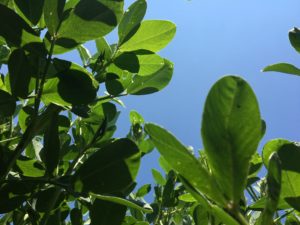
Once selections are complete, and this may take several generations, the seed is expanded to the point where statewide testing can be conducted. All breeding lines are tested in multiple locations in all production areas of Texas, as well as national testing programs throughout the United States. Breeding lines are evaluated for a minimum of 4 years for traits such as yield, grade, earliness, disease resistance, drought tolerance, shelling, roasting and flavor characteristics. Field testing remains the best way to determine how a possible variety will perform. The ability to test under varying production practices and many different environments are essential to the development of high-quality peanut varieties.
Once a breeding line has been evaluated and selected as a potential release it enters into the final phase of development known as the seed increase phase. At this level, purity is a major concern. For example, if a variety is advertised as nematode resistant, it must be verified as 100% for this trait. In many cases, this is done by testing tissue samples of the seed lot for the presence of molecular markers. This purified subset is then increased to the point that there is enough seed available for the growers. This is a 3 to 4-year process and involves the use of the Texas Foundation Seed Service in the later stages of development.
Faculty

Charles Simpson, Ph.D., Professor Emeritus

John Cason, Ph.D., Peanut Breeder
Team Members
- Brian D. Bennett, Senior Research Associate
- Alex Faith, Agricultural Research Technician I
- Jamie Shumaker, MS, Greenhouse Manager
- Emily Green, Project Coordinator
Publications
- Simpson, C.E. 2017. Finally, the Cross that Made Arachis monticola Krapov. & Rigoni and/or Arachis hypogaea L. Abstract in Proceedings at American Peanut Research and Education Society 49th. Annual Meeting. Albuquerque, NM July 11-13, 2017. Page 17.
- Simpson, C.E. 2017. Collecting, Preserving and Utilizing genetic diversity in Arachis. Presentation. Texas A&M Plant Breeding Symposium “The Vavllov Method: Utilizing Genetic Diversity.” February 16, 2016. Soil & Crop Sciences Dept. Texas A&M University. College Station, TX 77843.
- Simpson, C.E., J.L. Starr, M.R. Baring, M.D. Burow, J.M. Cason, J.N. Wilson. 2013. Registration of ‘Webb’ Peanut. Journal of Plant Registrations 7 (3): 265-268. doi 10.3198/jpr2013.01.0005crc.
- Simpson, C.E. 2012. Breeding Peanut, Chapter 36, pp 639-646. IN. Principles of Plant Genetics and Breeding. George Acquaah, Ed. ISBN 978-0470-66476-6. 758 pp. John Wiley & Sons, Inc. Hoboken N.J. 07030, USA.
- Simpson, C.E., M.D. Burow, and J.L. Starr. 2011. Developing Introgression Pathways for Gene Transfer to Arachis hypogaea L. Invited paper to: 5th Advances in Arachis through Genomics and Biotechnology 2011. Page 16, Book of Abstracts. http://www.cenargen.embrapa.br/aagb2011/. June 13-17, 2011. Brasilia DF, Brazil.
- Simpson, C.E. 1991. Pathways for introgression of pest resistance into Arachis hypogaea L. Peanut Science. 18:22-26.
- Simpson, C.E. and J.L. Starr. 2001. Registration of COAN Peanut. Crop Sci. 41:918.
- Simpson, C.E., J.L. Starr, M.D. Burow, A.H. Paterson 2003. Registration of ‘NemaTAM’ peanut Crop Sci. 43:1561.
- Simpson, C.E., O.D. Smith, and H.A. Melouk. 2000. Registration of Tamrun 98 Peanut. Crop Science 40: 859.
- Simpson, C.E., M.R. Baring, A.M. Schubert, H.A. Melouk, Y. Lopez, and J.S. Kirby. 2003a. Registration of ‘OLin’ Spanish Peanut. Crop Science 43:1880.
- Simpson, C.E., M.R. Baring, A.M. Schubert, H.A. Melouk, Y. Lopez, M.C. Black, and J.S. Kirby. 2003b. Registration of ‘Tamrun OL01’ Runner Peanut. Crop Science 43:2298.
- Simpson, C.E., M.R. Baring, A.M. Schubert, M.A. Black, H.A.Melouk, and Y. Lopez. 2006. Registration of ‘Tamrun OL02’ peanut. Crop Sci. 46: 1813-1814.
- Valls, J.F.M. and C.E. Simpson. 2005. New species of Arachis (Leguminosae) from Brazil, Paraguay and Bolivia. Bonplandia 14(1-2): 35-63.
- Valls, J.F.M. and C.E. Simpson 2017. A New Species of Arachis (Fabaceae) from Mato Grosso, Brazil Related to Arachis matiensis. Bonplandia 26(2): 143-149.
- Wilson, Jeffery N., Michael R. Baring, Mark Burow, William L. Rooney and C.E. Simpson, 2013 Diallel Analysis of Oil Production Components in Peanut (Arachis hypogaea L. International Journal of Agronomy. Vol. 2013. 5 pp. doi10.1155/2013/975701.
- Krapovickas A. and W.C. Gregory. 1994. Taxonomía del género Arachis (Leguminosae). Bonplandia 8(1-4):1-186. ISSN 0524-0476. English edition: Krapovickas, A. and W.C. Gregory. 2007. Taxonomy of the genus Arachis (Leguminosae). Translated by D.E. Williams and C.E. Simpson. Bonplandia 16 (Supl.): 1-205. ISSN 0524-0476.
- Nelson, S.C., C.E. Simpson, and J.L. Starr. 1989. Resistance to Meloidogyne arenaria in Arachis spp. germplasm. Supp. J. Nematol. 21:654‑660.
- Fávero, A.P., C.E. Simpson, J.F.M. Valls, and N.A. Vello. 2006. Study of the evolution of cultivated peanut through crossability studies among Arachis ipaënsis, A. duranensis, and A. hypogaea. Crop Science. 46: 1546-1552.
- Baring, M.R., Y. Lopez, C.E. Simpson, J.M. Cason, J. Ayers, and M.D. Burow. 2006a. Registration of ‘Tamnut OL06’ Peanut. Crop Science 46: 2720-2721.
- Baring, M.R., C.E. Simpson, M.D. Burow, M.C. Black, J.M. Cason, J. Ayers, Y. Lopez, and H.A. Melouk. 2006b. Registration of ‘Tamrun OL07’ Peanut. Crop Science 46: 2721-2722.
- Valls, J.F.M. and C.E. Simpson. 2005. Arachis porphyrocalyx Valls and C.E. Simpson sp.nov. pg. 36-38. IN: Valls, J.F.M. and C.E. Simpson. 2005. New species of Arachis from Brazil, Paraguay, and Bolivia. Bonplandia 14:1&2. 35-64.
- Valls, J.F.M., A. Krapovickas, and C.E. Simpson. 2005. Arachis submarginata Valls, Krapov. and C.E. Simpson sp.nov. pg. 38-41. IN: Valls, J.F.M. and C.E. Simpson. 2005. New species of Arachis from Brazil, Paraguay, and Bolivia. Bonplandia 14:1&2. 35-64.
- Simpson, C.E, A. Krapovickas, and J.F.M. Valls. 2005. Arachis Pflugeae C.E. Simpson, Krapov. and Valls sp.nov. pg. 41-43. IN: Valls, J.F.M. and C.E. Simpson. 2005. New species of Arachis from Brazil, Paraguay, and Bolivia. Bonplandia 14:1&2. 35-64.
- Krapovickas, A., J.F.M. Valls, and C.E. Simpson. 2005. Arachis Hassleri Krapov., Valls, and C.E. Simpson sp.nov. pg. 43-45. IN: Valls, J.F.M. and C.E. Simpson. 2005. New species of Arachis from Brazil, Paraguay, and Bolivia. Bonplandia 14:1&2. 35-64.
- Valls, J.F.M. and C.E. Simpson. 2005. Arachis interrupta Valls and C.E. Simpson sp.nov. pg. 45-47. IN: Valls, J.F.M. and C.E. Simpson. 2005. New species of Arachis from Brazil, Paraguay, and Bolivia. Bonplandia 14:1&2. 35-64.
- Valls, J.F.M., C.E. Simpson. A. Krapovickas, and R.F.de Arruda Veiga. 2005. Arachis seridoënsis Valls, C.E. Simpson, Krapov. and R. Veiga sp.nov. pg. 47-49. IN: Valls, J.F.M. and C.E. Simpson. 2005. New species of Arachis from Brazil, Paraguay, and Bolivia. Bonplandia 14:1&2. 35-64.
- Valls, J.F.M., A. Krapovickas, and C.E. Simpson. 2005. Arachis nitida Valls, Krapov., and C.E. Simpson sp.nov. pg. 49-52. IN: Valls, J.F.M. and C.E. Simpson. 2005. New species of Arachis from Brazil, Paraguay, and Bolivia, Bonplandia 14:1&2. 35-64.
- Valls, J.F.M., A. Krapovickas, and C.E. Simpson. 2005. Arachis linearifolia Valls, Krapov., and C.E. Simpson sp.nov. pg. 52-54. IN: Valls, J.F.M. and C.E. Simpson. 2005. New species of Arachis from Brazil, Paraguay, and Bolivia. Bonplandia 14:1&2. 35-64.
- Krapovickas, A., J.F.M. Valls, and C.E. Simpson. 2005. Arachis Schininii Krapov., Valls, and C.E. Simpson sp.nov. pg. 54-56. IN: Valls, J.F.M. and C.E. Simpson. 2005. New species of Arachis from Brazil, Paraguay, and Bolivia. Bonplandia 14:1&2. 35-64.
- Simpson, C.E., J.F.M. Valls, and A. Krapovickas. 2005. Arachis Gregoryi C.E. Simpson, Krapov., and Valls sp.nov. pg. 56-58. IN: Valls, J.F.M. and C.E. Simpson. 2005. New species of Arachis from Brazil, Paraguay, and Bolivia. Bonplandia 14:1&2. 35-64.
- Simpson, C.E., D.E. Williams, J.F.M. Valls, and I.G. Vargas. 2005. Arachis Krapovickasii C.E. Simpson, D.E. Williams, Valls, and I.G. Vargas sp.nov. pg. 59-61. IN: Valls, J.F.M. and C.E. Simpson. 2005. New species of Arachis from Brazil, Paraguay, and Bolivia. Bonplandia 14:1&2. 35-64.

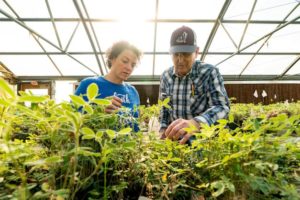 Drought tolerance in crops
Drought tolerance in crops